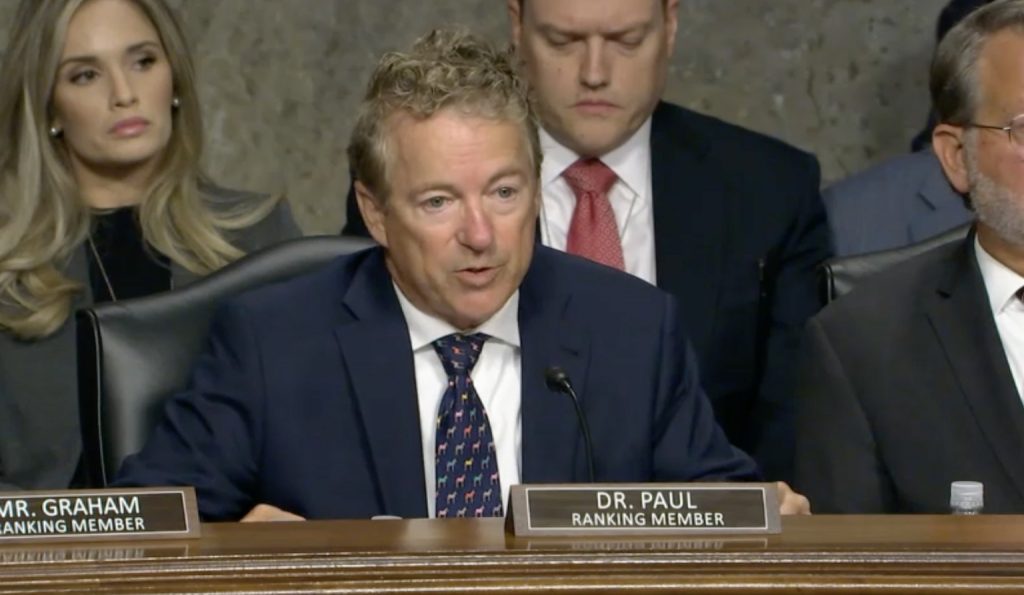WASHINGTON, D.C. – Today, U.S. Senator Rand Paul (R-KY), Ranking Member of the Senate Homeland Security and Governmental Affairs Committee, during a joint oversight hearing with the Senate Judiciary Committee, discussed the glaring security failures that resulted in an assassination attempt on former President Donald Trump. This devastating incident took the life of Corey Comperatore and injured other attendees at a rally in Pennsylvania on July 13th. The hearing, entitled “Examination of the Security Failures Leading to the Assassination Attempt on Former President Trump,” included testimony from U.S. Secret Service and Federal Bureau of Investigation officials regarding the ongoing investigations into the assassination attempt.
During today’s hearing, which is part of Dr. Paul’s bipartisan investigation into the attack in Pennsylvania, the Ranking Member raised concerns with Ronald L. Rowe Jr., Acting Director of U.S. Secret Service, about why former President Trump was allowed to take the stage despite law enforcement having knowledge of a suspicious individual in attendance. Several minutes before the start of former President Trump’s address, the Secret Service’s counter-sniper team received a photograph and detailed description of the suspicious individual. To better understand the Secret Service’s failures, Dr. Paul emphasized the need to hear directly from the Secret Service agents responsible and ensure they are not in charge of securing the upcoming Democratic National Convention or any future Trump rallies.

View the Ranking Member’s opening statement here and questioning here.
Opening remarks as prepared below:
Eighteen days ago, a would-be assassin managed to climb onto a roof 400 feet from the stage where the former President and leading presidential candidate, Donald Trump, was speaking. The assassin’s bullet struck President Trump, narrowly missing a fatal blow thanks to a last-second head turn.
Tragically, not everyone was so fortunate. A beloved husband and father in the audience was killed, his life stolen in an instant. Two others remain seriously injured, their futures uncertain.
The lives of law enforcement officers working the event and those in the audience have been forever changed.
Yet, the media has shamefully moved on to other stories, and Google has been caught trying to suppress iconic images of a bloodied Trump, images showcasing the resolve of our nation in the face of this attack. But the American people have not forgotten, and we will not forget.
There is no question that this was a monumental failure by the Secret Service. They had one job, and they failed. We know that. What remains unclear is who specifically failed, how they failed, and what must be done to ensure something like this never happens again.
America deserves to know that those responsible for this failure are not going to be in charge of securing the upcoming Democrat National Convention.
I was encouraged to hear that Acting Director Rowe had initiated a disciplinary investigation in addition to the ongoing Secret Service policy review. This is an important step. However, real accountability will require a comprehensive examination of all the facts, which still remain unclear.
This past Friday, my investigative team went to Pennsylvania to meet with local law enforcement and document the scene. One of the most concerning things my team was told is no one from the Secret Service has talked to them since the shooting.
I don’t know how an investigation into what failed can be conducted without talking to the officers and agencies relied upon to do much of the work.
Many questions remain unanswered about the planning and performance of the security for July 13. While a host of errors led to this security disaster, we now know local law enforcement officers were suspicious of the shooter 90 minutes in advance of the shooting.
There are two glaring issues we need to focus on right now. First, why were the AGR grounds and roof left unattended, and why was the AGR building, the shooter’s perch, left outside the perimeter?
Local law enforcement told my staff that they specifically flagged vulnerabilities about the AGR building to the Secret Service and were told it would be taken care of. Clearly, these vulnerabilities were not addressed.
Second, why was President Trump allowed to take the stage, and why was he not removed from the stage, when a suspicious individual was taking increasingly suspicious actions?
Over 20 minutes before President Trump began his address, the Secret Service command center had been made aware of “an individual with a rangefinder.”
At least 10 minutes before, it was confirmed the Secret Service’s counter-sniper team had been made aware of the suspicious subject and provided a photograph and a detailed description.
Why was the event not delayed until the individual was found and checked out?
Interviews with local law enforcement officers paint a different picture in critical places from what we have been told by the Secret Service in other briefings. Now we need to hear from the Secret Service agents responsible for security that day.
Our committee has formally requested interviews with those agents, but we have not yet been allowed to speak to them. I expect Director Rowe to tell us today when we will be able to talk to his people.
Finally, let me close with this. Mistakes, grave mistakes, were made on July 13 and before. But that does not take away from the bravery of dozens of federal, state, and local law enforcement officers that day. We are grateful for their sacrifices and professionalism. They deserve the truth too.
It is our duty, and our utmost responsibility, to ensure that we learn from this failure and hold those responsible accountable.
###